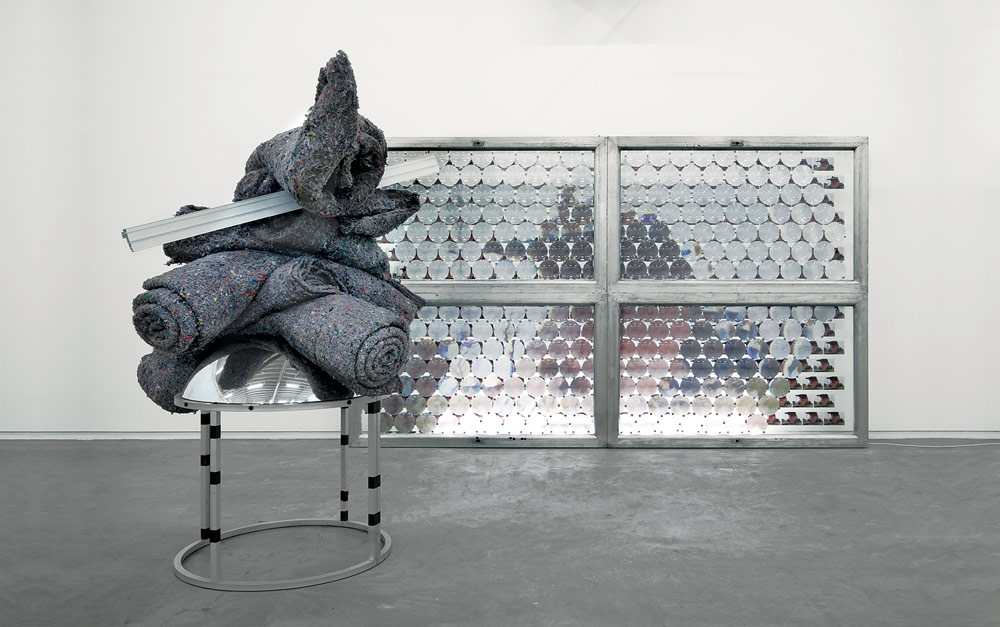It is unfortunate that during Jerry Pethick’s lifetime he was not a better-known artist. His posthumous retrospective, “Shooting the Sun / Splitting the Pie” at the Vancouver Art Gallery, began to rectify this. Let’s hope an even greater reappraisal continues.
From the 1960s until his death in 2003, Pethick explored the line between optics and perception, mostly in sculptural forms. Today the work looks so contemporary that it feels as if it were time travelling to the present. Consider Vermeeror (1995–97), a large collage that includes an old wool plaid shirt and a colour digital printout of a highly pixelated detail of a Vermeer painting. Stylistically, Pethick’s strange assemblages would sit comfortably next to work by American artists like Rachel Harrison or Zak Kitnick, not to mention Canadian artists like Geoffrey Farmer, Julia Feyrer or Gareth Moore, the latter of whom have been directly affected by Pethick. (He has a cult status among a generation of Vancouver artists, although his influence has not been properly recorded.)
The exhibition surveyed Pethick’s entire oeuvre, from autonomous sculptures like Sun Dogs / Actual and Virtual (1980–81) to Landscape: Portrait of Wittgenstein (1982) or Replica of Willendorf: Post-historic (1982), a sort-of series in which the figures are composed of light bulbs. There was so much to see and absorb in the exhibition, so many nuances to follow.
Often, Pethick’s work consists of objects associated with vision (light bulbs, lenses, photographs, cameras). Take, for instance, one of his most well-known bodies of work: elaborate sculptural objects he called “photo arrays,” large contraptions of small fresnel lenses arranged into a shape and hung on a wall, a number of which are on display. (Ironically, they do not photograph well.) The viewer can approach one of the lenses, discovering that it magnifies a photograph on the other side. Each lens has the same print placed behind it, creating an insect-like eye in the array.
Such disjunctive experiences define Pethick’s strange assemblages. In certain cases they can tell us a lot about the social and cultural world we find ourselves in. Does the 19th-century landscape painter Cornelius Krieghoff have anything to do with Inuit culture? KRIEGHOFF-ESKIMO PROXIMITY DEVICE (SLEIGH) (1977), a series of Pethick’s, contrasts Krieghoff with images of the North, particularly with objects from Inuit culture. Krieghoff Book (1976–79) is a codex made of glass planes, with each “page” bearing an etched image, some of which resemble motifs from Krieghoff’s paintings, others depicting images of the North. These pairings compare settler and Indigenous cultures in unexpected ways. It seems that Pethick is exploring how one culture sees a landscape as opposed to another, considering the possible implications on how those two cultures might interact as a result. But he avoids simple answers.
Because of its eccentricity, Pethick’s is not easy work. At first glance it appears quixotic—and perhaps fun for that reason, although also somewhat bewildering. The viewer can sense its design and intelligence, but the connections are not immediately apparent. The more time one spends, the more it comes into focus.
Taken together, Pethick’s work presents a mind that, through sculpture, assemblage and collage, tried to understand how we see, and what implications our ways of seeing have on us. In its own way, it continues to tell us something about the world in which we live, in terms of both content and style, even though it was made decades ago. Let’s hope we see more of it.
Aaron Peck is a Canadian writer currently living in Brussels. His writing has been published in Artforum and Joyland, and he is the author of The Bewilderments of Bernard Willis and Jeff Wall: North & West.
This is a review from the Spring 2016 issue of Canadian Art. To read more from this issue, visit its table of contents. And to get each issue of our magazine before it hits newsstands, subscribe now.

 Jerry Pethick, Out of the Corner of an Eye, 1990.
Jerry Pethick, Out of the Corner of an Eye, 1990.







